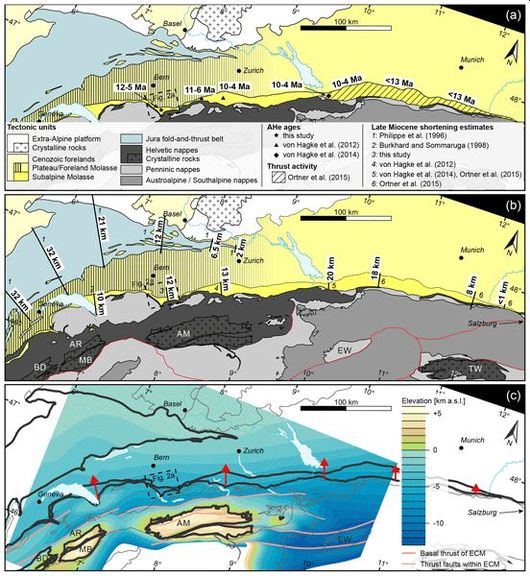Neuer Open Access Artikel in Solid Earth zieht die Grenze zwischen Ost- und Westalpen neu.
Wie stark haben sich die Störungen an der Alpenfront in den letzten 12 Millionen Jahren bewegt und wie hängt diese Bewegung mit dem tiefen Untergrund zusammen?
Diese Frage ist alles andere als akademisch. Die zeitliche und räumliche Entwicklung der Deformationsfront der Alpen zu kennen ist wichtig, z.B. um geeignete Stellen für geothermische Energie zu finden, die Reaktion des Gebirges auf klimatische Schwankungen zu verstehen, oder das Erbebenrisiko bestimmter Regionen abschätzen zu können. In einer neuen Studie, die eben in SolidEarth veröffentlicht wurde, konnte gezeigt werden, dass die Hebungssignale der Deformationsfront entlang des Alpenbogens vom Genfer See bis etwa Salzburg relativ konistent sind. In Verbindung mit bekannten geophysikalischen Daten konnte gezeigt werden, dass im tiefen Untergrund die Grenze zwischen Ost- und Westalpen viel weiter östlich liegt als aus der Oberflächengeologie zu vermuten war.
Das bedeutet, dass die Geometrien der Deformationsfront im Alpenvorland zwischen Salzburg und Genfer See mindestens teilweise von der Größe der abtauchenden Europäischen Platte anstatt von oberflächennaher Tektonik geprägt sind. Link zum Artikel:
https://se.copernicus.org/articles/11/1823/2020/
How strong have the faults of the Alpine front moved over the last 12 million years and how is this movement related to the deep underground?
This question is anything but academic. Knowing the time and space evolution of the deformation front of the Alps is important, e.g. to find suitable locations for geothermal energy, to understand the reaction of the mountains to climatic variations, or to estimate the earthquake risk of certain regions. In a new study just published in SolidEarth it could be shown that the uplift signals of the deformation front along the Alpine arc from Lake Geneva to Salzburg are relatively consistent. In combination with known geophysical data it could be shown that in the deep underground the border between the Eastern and Western Alps lies much further to the east than could be assumed from the surface geology. This means that the geometries of the deformation front in the Alpine foreland between Salzburg and Lake Geneva are at least partially characterized by the extent of the descending European Plate rather than by near-surface tectonics. 




